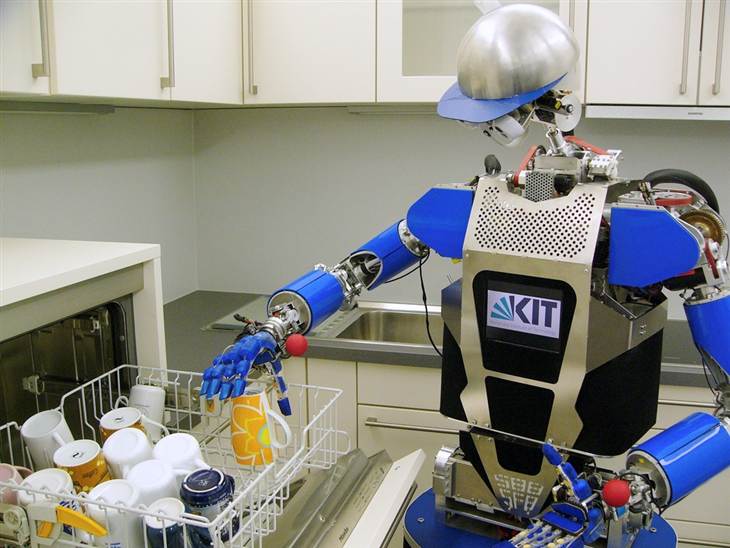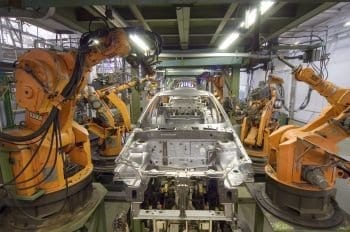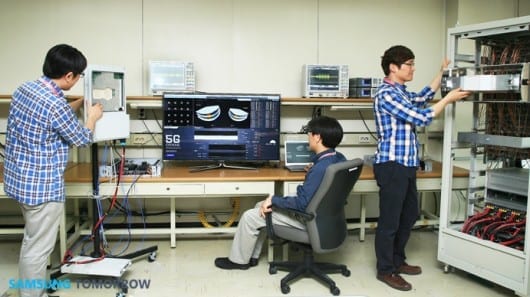
Science fiction is quickly taking a back seat to science fact. Just look at a new report by the country’s leading roboticists. By 2030, it says, robots will be everywhere.
At the gym, they’ll help you train. In operating rooms, flea-sized robots will zip through your blood vessels to repair tissues. Using voice commands and hand gestures, humans will control robots in the cold vacuum of space, while bots deep underwater and high in the air will collaborate to protect the U.S. from natural disasters and military threats.
That’s the robot future envisioned by researchers at top U.S. universities including Georgia Tech, MIT, Stanford and Carnegie Mellon. In the collaborative report, they predict that robots will become “as ubiquitous over the next decades as computer technology is today.”
At home and in the operating room
In surgery, robots will not only match human skills, by 10 and 15 years from now, they will likely surpass them.
First come the snake-like robots, performing endoscopic surgeries. After about 10 years, untethered robots about a centimeter across will be sent into the body to “remove polyps or modulate blood flow,” according to the report. Think “Fantastic Voyage,” minus the teeny tiny Raquel Welch. Fifteen years out, these robots will have shrunk to the size of fleas, to “swim through bodily fluids and bore through tissue to perform highly localized therapies.”
Advances in miniaturization will help this trend pan out as predicted, Henrik Christensen — director of the Center for Robotics and Intelligent Machines at Georgia Tech, and co-author of the robotics report — told NBC News. At a recent conference, researchers showed they could track and control the movements of a magnetic bacterium inside a tiny maze.
Exoskeletons like Ekso and Indego are already becoming lighter, easier to wear and use. In 10 years, prosthetics will begin to “match that of biological capabilities,” and yes, “Iron Man” fans, in 15 years, they “will enable the human user to become better than human.” (Just don’t expect your supersuit to come with pulsating energy weapons.
Robot butlers will help bathe and dress people with disabilities, not just in doctor’s offices or hospitals, but at home.
“For people who have lost their memory, even simple things like remembering to get food and water are very hard,” Christensen said. “Having a robot that reminds you, ‘Did you get your water?’ or ‘Did you have lunch?’ — that’s a huge deal.”
Robots for health care have been developing slower than anticipated, Christensen said, but that’s in part due to the delicacy of their work. “We need to be comfortable that they are really good enough before we’re able to give them more functionality.”
The Latest Bing News on:
Dawn of the bot
- Boston Dynamics gives Spot bot a furry makeoveron April 30, 2024 at 12:04 pm
PM EDT Boston Dynamics may have relocated the bipedal Atlas to a nice farm upstate, but the company continues to let everyone know its four-legged line of Spot robots have a lot of life left in them.
- This ‘boring’ mid laner could finally be returning to the bot lane in LoL Patch 14.10on April 30, 2024 at 1:38 am
Riot Games developer David “Phreak” Turley released a video outlining a series of crucial Corki changes coming to Patch 14.10. The champion is getting an overhaul ...
- Dawn of the Planet of the Apes Is a Heartbreaking, Heavenly Filmon April 29, 2024 at 1:30 pm
Director Matt Reeves was not messing around when he made Dawn of the Planet of the Apes. He wipes out most of the human race before the title card, then unfurls a powerful story of two opposing ...
- Replacement Straw Compatible with Stanley 40 oz 30 oz Cup Tumbler, Now 57% Offon April 27, 2024 at 8:07 am
If you purchase the Replacement Straw Compatible with Stanley Cup Tumbler off Amazon, they also offer a full refund or an exchange if you're not satisfied with the product for any reason. This ...
- How to get the Wasteland Solar Tower Chest in Stellar Bladeon April 25, 2024 at 5:01 am
To get the Wasteland Solar Tower Chest in Stellar Blade you need to activate all four Tetrastar consoles before climbing to the chest . First things first, you need to face the Solar Tower and then ...
- Sydney counter-terror raids – as it happenedon April 24, 2024 at 1:26 am
This blog is now closed.
- ‘Your Name,’ ‘The Garden of Words’ Artist Yoshitoshi Shinomiya Makes Feature Directorial Debut With ‘A New Dawn’ (EXCLUSIVE)on April 23, 2024 at 3:12 am
France work-in-progess will be showcased at this year's Annecy Animation Showcase, part of the Marché du Film's Animation Day.
- Indie Darling Maggie Rogers Defies Ticket Bots, Fans Line Up at Chicago's House of Blues in Show of Supporton April 20, 2024 at 2:50 am
Fans lined up in Chicago to buy in-person tickets for Maggie Rogers' show, a response to online ticketing issues.
- Open-world action game Unending Dawn adds PS5 version, ‘The Flame of Faith, Everlasting’ gameplay traileron April 18, 2024 at 9:45 pm
Chinese developer Parcae’s Fate Studio has released a seven-minute gameplay trailer for open-world action game Unending Dawn, as well as announced it will launch for PlayStation 5 in ...
- Transformers One Trailer Takes the Optimus Prime Origin Story in a Bizarre Directionon April 18, 2024 at 11:09 am
The long-awaited trailer for Transformers One has finally been released and it… was not what anyone was expecting.
The Latest Google Headlines on:
Dawn of the bot
[google_news title=”” keyword=”Dawn of the bot” num_posts=”10″ blurb_length=”0″ show_thumb=”left”]
The Latest Bing News on:
Robots are everywhere
- Opinion: How robots making your burger and fries can lead to greater income inequalityon May 1, 2024 at 3:01 am
Restaurants still need humans to do much of the labor. Working people deserve to have their voices heard in determining how, when or whether AI and automation should be used.
- Robots can use air to move objectson April 30, 2024 at 11:00 am
This technique has the potential to revolutionize how we think about robotics, manufacturing, and even everyday tasks. Inspired by nature The fundamental concept behind this innovation is quite simple ...
- China Birthrate, Robots To Move Factories To Africaon April 29, 2024 at 4:33 pm
The emergence of green technology has once again put African manufacturing in the spotlight.In February, African leaders submitted a propo ...
- Humanoid robots are learning to fall wellon April 28, 2024 at 1:15 pm
Ultimately, “Farewell to Atlas” is as much a celebration as it is a blooper reel. It’s a welcome reminder that for every time the robot sticks the landing on video there are dozens of slips, falls and ...
- Sanctuary AI CEO - the robots really are coming! Thanks to transformer AIon April 26, 2024 at 6:44 am
Robotics is really about ‘embodied AI’, says the CEO of Sanctuary AI, whose vision of robots’ future is now close to the one predicted by sci-fi. Meanwhile: the real transformers are… us.
- The best robot vacuum mops of 2024: Expert tested and reviewedon April 25, 2024 at 12:54 pm
We've tested top robot vacuum and mop combos from brands like iRobot, Roborock, Ecovacs, and Dreame to find out which can keep a home clean.
- Meet Thermonator, a flame-throwing robot dog with 30-foot range being sold by Ohio companyon April 25, 2024 at 11:39 am
Throwflame, a Cleveland-based company, has unveiled a new invention aptly named Thermonator, a flame-thrower and robot dog all in one.
- New scientific interventions are here to fight climate change. But they aren’t silver bulletson April 22, 2024 at 3:00 am
Giant sun shades, 40-foot-tall air filters, stratospheric sulfur injections: Here are some of the wild and wondrous ways we might save the planet.
- The Husqvarna DXR 95 is its most compact demolition robot ever producedon April 22, 2024 at 1:42 am
Husqvarna Construction’s new DXR 95 demolition robot is designed to deliver power, while remaining easily portable.
- Mobileye founder gives sneak peek into human-like AI robot doing household choreson April 18, 2024 at 9:38 am
Israeli startup Mentee Robotics debuts prototype of general-purpose robot that can move everywhere, clean dishes, do the laundry, work in warehouses... and learns on the fly ...
The Latest Google Headlines on:
Robots are everywhere
[google_news title=”” keyword=”robots are everywhere” num_posts=”10″ blurb_length=”0″ show_thumb=”left”]










